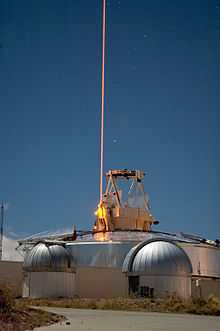Sodium layer

Refers to a layer within the Earth's mesosphere of unbound, non-ionized atoms of sodium. The altitude of this layer is usually located between 80–105 km (50–65 miles) and has a depth of about 5 km (3.1 mi). The sodium comes from the ablation of meteors. Atmospheric sodium below this layer is normally chemically bound in compounds such as sodium oxide, while above the layer the atoms tend to be ionized.
The density varies with season; the average column density is roughly 4 billion sodium atoms/cm2.[1]
Atoms of sodium in this layer are typically in an excited state, and radiate weakly at a wavelengths around 589 nm, which is in the yellow portion of the spectrum. These radiation bands are known as the sodium D lines. The resulting radiation has been termed night glow.
Astronomers have found the sodium layer to be useful for creating an artificial laser guide star in the upper atmosphere. The star is used by adaptive optics to compensate for movements in the atmosphere. As a result, optical telescopes can perform much closer to their theoretical limit of resolution.
The sodium layer was first discovered in 1929 by American astronomer Vesto Slipher. In 1939 the British-American geophysicist Sydney Chapman proposed a reaction-cycle theory to explain the night-glow phenomenon.
External links
References
- ↑ Ageorges, N.; Hubin, N.; Redfern, R.M. (1999), "Atmospheric Sodium Column Density Monitoring" (PDF), ESO Conference and Workshop Proceedings (Garching: European Southern Observatory) 56, Bibcode:1999ESOC...56....3A, retrieved 2011-09-04